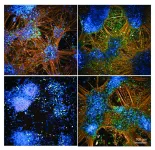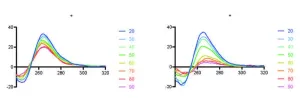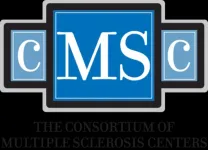(Press-News.org) In humans, the exact same mutation in a specific gene can produce widely different outcomes. It’s a bit like adding the same amount of salt to different recipes—the effect on the finished dish can be quite different, depending on the mix of other ingredients. Now, researchers at The Jackson Laboratory (JAX) have developed a powerful platform to study the reasons behind these varying mutation outcomes. The work, published today in Science Advances, not only provides new opportunities for uncovering targets for therapeutic interventions but also represents a significant step forward in addressing the critical need for studying human disease in the context of genetic diversity.
The platform, developed by JAX Professor Martin Pera, Ph.D. and Associate Research Scientist Daniel Cortes, Ph.D., and their colleagues, uses stem cells from eight different mouse strains to mimic the genetic diversity seen in humans. With the platform, they were able to investigate the effects of background genetics on the DYRK1A gene, long associated with autism, microcephaly, and intellectual disability in humans. The result: Chemically inhibiting the function of DYRK1A or knocking the gene out within the stem cells from the eight mouse strains led to markedly different effects in the growth and repair of neurons, providing molecular insights into what may confer resistance or vulnerability to the development of autism.
“If we studied one strain, we wouldn’t have seen this incredible degree of variation,” said Pera. “But by studying eight, we showed that stem cell models in a dish can accurately predict an individual’s sensitivity or resilience to disease-causing mutations, in this case an autism syndrome disorder. Careful comparison of sensitive and resilient mouse strains at the cellular level also enabled us to identify potential targets for therapeutic intervention.”
To create the platform, Pera, Cortes and colleagues, including JAX Associate Professors Laura Reinholdt, Ph.D., and Kristen O’Connell, Ph.D., had to overcome a key obstacle. They found that only the stem cells from mouse strain 129S1/SvlmJ (129) could be coaxed into differentiating into neurons using commonly used protocols. The JAX team – and this is the innovation -- developed protocols that worked across all eight strains and, with modification, produced multiple neuron types with high efficiency.
In previous work, Pera also investigated DYRK1A in human-induced pluripotent stem cells (iPSC), derived from adult skin or blood cells that can be induced to become stem cells. These stem cells can then re-differentiate into any cells in the body given specific genetic instructions, a state known as pluripotency. The protocols developed for the mouse cell lines were effective in generating the same neuron types from multiple pluripotent human stem cell lines, validating the results obtained in the mouse cell platform.
Further investigation revealed that one mouse strain, C57BL/6J (B6), most closely modeled the human iPSC response to low DYRK1A levels or inhibition during neural cell specification and expansion. The strains least affected were WSB/EiJ (WSB) and NZOHiLtJ (NZO). B6 and WSB also showed highly divergent responses to axonal injury. Comprehensive comparisons between strains highlighted the molecular mechanisms that define these differences, previously implicated in neurodevelopmental disorders.
Finally, Pera's team worked with Zhong-Wei Zhang, Ph.D., at JAX to study live mice to see if the B6 susceptibility observed in the mouse stem cells was reflected in a living system. Or, rather, not living, as they found that even the loss of one copy of Dyrk1a resulted in no live offspring with a B6 background, while it did not affect survival in other backgrounds, including 129. Crossing B6 with 129 mice, however, resulted in live offspring with clinical features associated with DYRK1A mutations in humans, suggesting an effective mouse model for diseases such as Alzheimer’s, Down syndrome, microcephaly, autism, and intellectual disability.
“This work illustrates the power of incorporating genetic diversity into disease models,” said Pera. “The use of stem cells in vitro allows us to directly compare mouse and humans, and to bridge results in a petri dish to those in a whole organism. The approach will have wide application in disease genetics and will enhance and accelerate precision disease modeling in the mouse.”
END
JAX researchers make mice a more powerful tool to study a wide range of human diseases
A new protocol sets the stage for researchers to directly compare mouse and human cells, and readily incorporates genetic diversity into mouse-based research to more closely approximate human health conditions
2024-04-03
ELSE PRESS RELEASES FROM THIS DATE:
Immunotherapy for Alzheimer’s disease shows promise in mouse study
2024-04-03
Alzheimer’s disease starts with a sticky protein called amyloid beta that builds up into plaques in the brain, setting off a chain of events that results in brain atrophy and cognitive decline. The new generation of Alzheimer’s drugs — the first proven to change the course of the disease — work by tagging amyloid for clearance by the brain’s immune cells.
Now, researchers at Washington University School of Medicine in St. Louis have found a different and promising way to remove the noxious plaques: by directly mobilizing immune cells to consume ...
Study gives first view of centromere variation and evolution
2024-04-03
A genomic study of human and selected nonhuman primate centromeres has revealed their unimaginable diversity and speed of evolutionary change.
In cell genetics, a centromere is the spot where two sister chromatids attach. A chromatid is one-half of a duplicated chromosome. United pairs of chromosomes have identifiable shapes because centromeres are not in a uniform position. As a cell prepares to divide, the machinery to separate and segregate chromosomes goes into action at each centromere location.
Unless the genetic material ...
New tools reveal how genes work and cells organize
2024-04-03
Proteins binding to RNA are important in many processes in the cell and can mediate a range of biological functions. A specialized structure in both DNA and RNA, the G-quadruplex, are regulatory elements involved in gene expression in both DNA and RNA. In the present work the researchers use theoretical predictions and molecular biology experiments to show that many chromatin-binding proteins bind to RNA G-quadruplexes. With this information they can classify proteins based on their potential to bind RNA G-quadruplexes.
The study uses a combination of experimental identification of RNA G-quadruplex-binding proteins and computational methods to build a prediction tool that identify the probability ...
New study shows LLMs respond differently based on user’s motivation
2024-04-03
A new study recently published in the Journal of the American Medical Informatics Association (JAMIA) reveals how large language models (LLMs) respond to different motivational states. In their evaluation of three LLM-based generative conversational agents (GAs)—ChatGPT, Google Bard, and Llama 2, PhD student Michelle Bak and Assistant Professor Jessie Chin of the School of Information Sciences at the University of Illinois Urbana-Champaign found that while GAs are able to identify users' ...
Top multiple sclerosis neurologists & scientists to headline CMSC Annual Meeting for healthcare professionals
2024-04-03
The leading research and educational conference for multiple sclerosis healthcare professionals in North America, the Consortium of Multiple Sclerosis Centers (CMSC) 38th Annual Meeting, returns to Nashville, Tennessee, May 29-June 1, 2024 at the Music City Center. The conference is renowned for its emphasis on reaching the interprofessional team involved in MS care, with learning opportunities for physicians, advanced practice clinicians, nursing professionals, pharmacists, mental health and rehabilitation specialists, dietitians, researchers, advocates and other members of the healthcare team involved in the management of people with MS.
...
Novel fabrication technique takes transition metal telluride nanosheets from lab to mass production
2024-04-03
Transition metal telluride nanosheets have shown enormous promise for fundamental research and other applications across a rainbow of different fields, but until now, mass fabrication has been impossible, leaving the material as something of a laboratory curiosity rather than an industrial reality. But a team of researchers has recently developed a novel fabrication technique—the use of chemical solutions to peel off thin layers from their parent compounds, creating atomically thin sheets—that looks set to finally deliver on the ultra-thin substance's promise.
The researchers describe their fabrication technique in a study published in Nature on April 3.
In ...
Two Jurassic mammaliaforms from China shed light on mammalian evolution
2024-04-03
Mammaliaforms are extinct and extant organisms that are closely related to mammals. Studying mammaliaforms helps scientists understand the evolutionary processes that led to various mammalian features.
In two consecutive studies in Nature, Dr. MAO Fangyuan and Dr. ZHANG Chi from the Institute of Vertebrate Paleontology and Paleoanthropology (IVPP) of the Chinese Academy of Sciences, together with colleagues from Australia and the United States, recently reported two Jurassic mammaliaforms from China, revealing the earliest dental diversification, mandibular middle ears, and articular-quadrate joint transformation of mammaliaforms.
The ...
Socioecologic factors and racial differences in breast cancer prognostic scores
2024-04-03
About The Study: The findings of this study suggest that the consequences of structural racism extend beyond inequities in health care to drive disparities in breast cancer outcome. Additional research is needed with more comprehensive social and environmental measures to better understand the influence of social determinants on aggressive estrogen receptor-positive tumor biology among racial and ethnic minoritized women from disadvantaged and historically marginalized communities.
Authors: Gregory S. Calip, Pharm.D., M.P.H., Ph.D., of the University of Southern California in Los Angeles, is the corresponding author.
To access the embargoed study: ...
Disparities in mentorship and implications for surgical resident education and wellness
2024-04-03
About The Study: In a survey study of residents of all accredited general surgery programs, one-third of trainees reported lack of meaningful mentorship, particularly non-white or Hispanic trainees. Although education and wellness are multifactorial issues, mentorship was associated with improvement; thus, efforts to facilitate mentorship are needed, especially for minoritized residents.
Authors: Yue-Yung Hu, M.D., M.P.H., of Northwestern University in Chicago, is the corresponding author.
To access the embargoed study: Visit our For The Media website at this link ...
Intelligent liquid
2024-04-03
Researchers from the Harvard John A. Paulson School of Engineering and Applied Sciences (SEAS) have developed a programmable metafluid with tunable springiness, optical properties, viscosity and even the ability to transition between a Newtonian and non-Newtonian fluid.
The first-of-its-kind metafluid uses a suspension of small, elastomer spheres — between 50 to 500 microns — that buckle under pressure, radically changing the characteristics of the fluid. The metafluid could be used in everything ...
LAST 30 PRESS RELEASES:
Be careful trusting TikTok for gout advice
A study by the University of Seville links the vanishing of the specific heats at absolute zero with the principle of entropy increase
Anxiety and insomnia may lower natural killer cell count, potentially repressing immune function
How parasitic, asexual plants evolve and live
Research spotlight: A subset of patients with depression could benefit from anti-inflammatory treatment
New fully digital design paves the way for scalable probabilistic computing
Membrane electrode assembly design for high-efficiency anion exchange membrane water electrolysis
U.S. debt ceiling disputes show measurable impact on global crude oil markets
Climate extremes triggered rare coral disease and mass mortality on the Great Barrier Reef
Direct observation reveals “two-in-one” roles of plasma turbulence
Humans rank between meerkats and beavers in monogamy ‘league table’
US fossil reveals early mass-burial event and ancient microbial attack
Sedative choice could improve outcomes for breathing tube patients
New superconducting thin film for quantum computer chips
Simulations reveal protein "dynamin" constricts cell membranes by loosening its grip
Nearly 1 in 5 UK emergency department patients cared for in corridors/waiting rooms
Heavy energy drink intake may pose serious stroke risk, doctors warn
Violence against women and children among top health threats: New global study reveals disease burden far larger than previously estimated
Predicting who is at risk of developing type 1 diabetes, as new drugs now available
New gene-mapping method unlocks hidden drivers of cancer
Ocean current and seabed shape influence warm water circulation under ice shelves
Call to increase funding for ‘invisible’ Deaf victim-survivors of domestic abuse
University of Maryland School of Medicine names distinguished scientist and academic leader Gerald M. Wilson, PhD, as Chair of the Department of Biochemistry and Molecular Biology
Receptors in mammary glands make livestock and humans inviting hosts for avian flu
Icy hot plasmas
Treating adults with autism: Maryland Clinical Center offers national blueprint for care after pediatric transition
University of Phoenix College of Doctoral Studies releases white paper on reclaiming control to build workforce resilience
NCCN Summit seeks to improve care for veterans and first responders with cancer from line-of-duty exposure
ERC Consolidator Grant for soft robotics researcher
Dual-action arts and wellbeing program transforms dementia care
[Press-News.org] JAX researchers make mice a more powerful tool to study a wide range of human diseasesA new protocol sets the stage for researchers to directly compare mouse and human cells, and readily incorporates genetic diversity into mouse-based research to more closely approximate human health conditions






